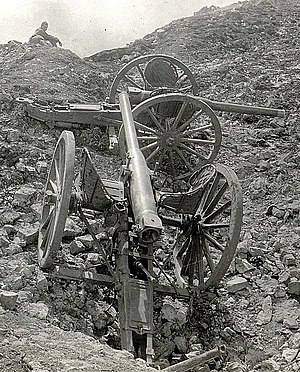The Cannone da 70/15 was a mountain gun was used by Italy during World War I. By World War II it had been relegated to the infantry gun role in units assigned to Italian East Africa.[2]
| Cannone da 70/15 | |
|---|---|
 Two guns captured by the Austrians during 1916. | |
| Type | Mountain gun |
| Place of origin | |
| Service history | |
| In service | 1903–1943 |
| Used by | Italy |
| Wars | Italo-Turkish War World War I Second Italo-Ethiopian War World War II |
| Production history | |
| Designer | Captain Regazzi |
| Designed | 1902 |
| Manufacturer | Vickers-Terni |
| Produced | 1902–1914 |
| Specifications | |
| Mass | 387 kg (853 lb) |
| Barrel length | 1.15 m (3 ft 9 in) L/16.4 |
| Shell | 70 x 86 mm R[1] |
| Shell weight | 4.84 kg (10 lb 11 oz) |
| Caliber | 70 mm (2.8 in) |
| Breech | Interrupted screw |
| Recoil | None |
| Carriage | Box trail |
| Elevation | -12° to 21° |
| Traverse | 0° |
| Rate of fire | 8 rpm |
| Muzzle velocity | 353 m/s (1,158 ft/s) |
| Maximum firing range | 6.6 km (4.1 mi)[2] |
Background
editThe 70/15 was designed in 1902 by Italian artillery Captain Regazzi to replace the Canonne da 7 BR Ret. Mont. that was first introduced in 1881. The 70/15 was technically obsolescent when it went into service in 1904 but it took the Italians almost a decade to field its replacement the Cannone da 65/17 modello 08/13.
Design
editThe 70/15 was a breech-loaded mountain gun with an interrupted screw breech, a box trail carriage, two wooden-spoked steel-rimmed wheels, and two seats on the axles for the gunners. There was no recoil mechanism, no gun shield, no traversing mechanism, and elevation was controlled by a jackscrew beneath the breech. It could be broken down into four mule loads for transport or hooked to a limber for towing.
History
editThe 70/15 was first used during the Italo-Turkish War by the 3rd Mountain Artillery Regiment. The 70/15 was still in service during World War One due to insufficient numbers of more modern replacements. Due to its light, simple, inexpensive, and rugged construction Vickers-Terni built 710 70/15s from 1914-1919, and it remained in colonial service throughout World War II. It was gradually phased out of the mountain role and given a new role as an infantry support gun.[3]
After World War One most were transferred to the Italian Border Guard. At the outbreak of World War Two, 92 guns were still in service with the I Group/1° GaF Artillery, the VII Group/2° GaF Artillery, and IIbis Group/3° GaF Artillery in Albania.[4] In Italian East Africa, the 70/15 was used by the XCI Colonial Artillery Group/XCI Colonial Brigade, the XCII Colonial Artillery Group/XCII Colonial Brigade, and the CI Colonial Artillery Group.[5]
Photo Gallery
edit-
Two guns converted to anti-aircraft use that were captured by the Austrians.
-
A 70/15 in position on Monte Ortigara
-
A captured gun and limber.
References
edit- ^ "48-57 MM CALIBRE CARTRIDGES". www.quarryhs.co.uk. Archived from the original on 2017-10-11. Retrieved 2017-10-02.
- ^ a b Chamberlain, Peter (1975). Infantry, mountain, and airborne guns. Terry Gander. New York: Arco. ISBN 0-668-03819-5. OCLC 2067391.
- ^ Cappellano, Filippo (2005). La produzione italiana nella prima guerra mondiale. Italy: Tecnologia&Difesa. p. 91.
- ^ "Le artiglierie italiane nella 2ª Guerra Mondiale". xoomer.virgilio.it. Retrieved 2021-04-10.
- ^ "La Guardia alla Frontiera al 10 Giugno 1940". xoomer.virgilio.it. Retrieved 2021-04-10.